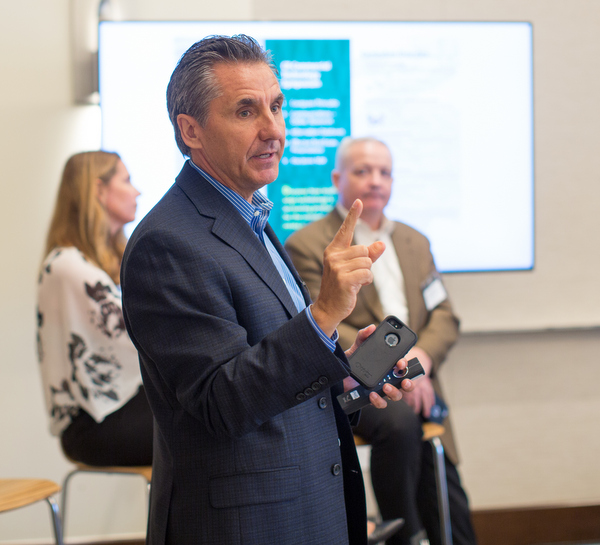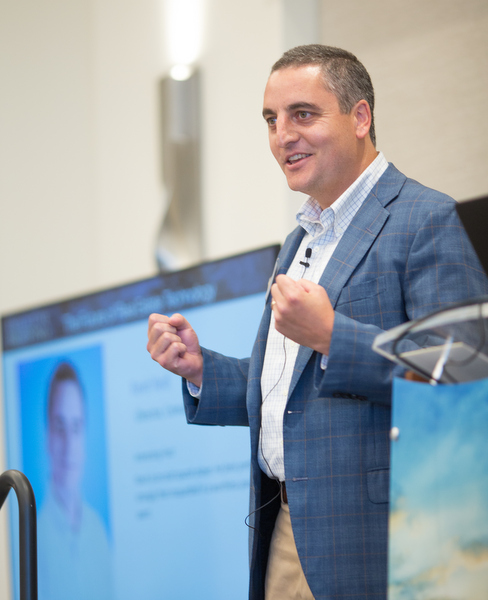By Melissa Minnini on December 7, 2016 in Technology
In 1992, the founder and CEO of Realcomm made a prediction. Jim Young wrote an article entitled “The Information Age and the Potential Effects on the Commercial Real Estate Market” forecasting a world in which reporters armed with “personal communicator” devices would relay information to editors, who pass it through an electronic distribution system to reach consumers in their home.

As you read this on your smartphone, take a second to remember that Young made that prediction more than twenty years ago. Young describes that period as “Phase 1” of commercial real estate technology (CRE tech). It was a time of growing software implementation, marked by Windows-based property management software and the early days of building automation.
Today, we’re entering Phase 5 of CRE tech, a realm of artificial intelligence (AI), blockchain and augmented reality. How did we get from there to here? Did the real estate industry successfully make the jump? And what the heck is blockchain?
To answer those questions and more, I caught up with Jim Young and Kevin Yardi. Both recently spoke at the Yardi Executive Briefing, an invitation-only gathering for clients. Yardi opened his talk about the future of CRE tech by citing Young’s paper and the early days of Yardi Systems. As Yardi put it, “To look five or ten years forward, you get some context by first looking 30 years back.”
Bridging the Tech Gap
Thirty years ago, Yardi was founded as the tech world transitioned from mainframes to personal computers. These days, the majority of Yardi clients use Voyager 7S or Genesis2, hosted on the Yardi Cloud and accessed from a PC, laptop, tablet or smartphone.
There’s an often mentioned belief that the real estate industry has lagged when it comes to technology adoption. While early adopters and visionaries quickly implement the latest and greatest tech, others prefer to take their time. “Tech is a short-term, high-speed industry,” says Young. “In real estate, it’s long-term everything. Last year the tech industry was going 100mph and real estate was at 30mph. With all this new stuff coming out of Silicon Valley, tech is about to go 200mph, and we need to bridge that gap.”
Yardi echoes this sentiment. “When you’ve had an industry that’s been historically profitable by taking things slow and easy, why rock the boat?” However, he characterized most Yardi clients as early adopters. It’s those early adopters and thoughtful risk-takers who will have an edge in the years to come. Both Yardi and Young agree that more change is coming from all directions.
Making Smarter Connections

When it comes to technology, progress emerges from a combination of consumer demand and industry innovation, which introduces tools we didn’t know we couldn’t live without. Case in point: the smartphone. Who’d have guessed, back in 1992, that we’d soon be running our businesses and our daily lives on them?
When technology catches on quickly for consumers, it creates a demand that ripples into our industry. With smartphones in our pockets we have the ability to shop, pay bills, conduct research and communicate online. We start to want these conveniences in the workplace. In real estate, that affects how we interact with real properties in a multitude of roles, whether we are tenants, property owners, or asset managers. If a CRE tenant is used to paying rent and browsing for home furnishings online, why wouldn’t he also expect to request maintenance, buy printer ink and pay the lease online?
“We’re thinking now in terms of connected communities,” says Yardi. “Our clients are changing from just being the owners and managers of the properties, to encompass the tenants, brokers, leasing agents… it’s an entire ecosystem whose framework is based on cloud computing and mobile access.”
Young stresses that the Millennials will be the leaders of the new business world, and their preferences will dictate how buildings are configured and managed. This is a cohort that doesn’t care about the corner office – they want collaborative, open concept spaces, flex time and a barista in the corner. They value the environment, so they’re going to want smart, ecofriendly buildings, and if your firm can’t process funds electronically they’ll wonder how you are still in business.
Adoption and Advancement
Some companies are devoting significant financial and human resources to implementing CRE tech at an advanced pace. As Young put it, “They’re not waiting. They’re leaning in.” For many, this means EFT and the Internet of Things. Others are leading the charge on integrating augmented reality, drone technology and artificial intelligence.
These buzz words can be daunting in an industry that’s not known for tech adoption but, as Yardi stresses, many clients are already implementing these technologies to varying degrees. The multifamily sector is filled with early adopters of electronic accounts receivable tools like Yardi Payment Processing and accounts payable options like Yardi Procure to Pay. Commercial clients are starting to adopt these online payment tools as their employees and tenants, used to these conveniences in daily life, begin to expect them in their workplaces. Similar adoption trends are occurring with internet-connected devices, like Yardi LOBOS®, an intelligent HVAC system for large commercial buildings, and Proliphix, which manages smart thermostats for clients with multiple small commercial properties.
“Innovation is simply a fancy word for progress,” says Young. “Over time, we shorten a process, take it from ten steps, to seven steps, to five, to two. We keep refining. I don’t think there’s any chance we’re ever going to stop progressing, so this innovation thing is something that we have to embrace.”
Kevin Yardi forecasts a bright future. “Yardi is a simple business in the sense that we don’t have to report to Wall Street every quarter. We think one, two, or three years down the road when we develop products, and that allows us to focus closely on our clients. I think if that continues, then what’s happened in the past 30 years will continue.”
This is good news for the commercial real estate clients who are trying to bridge the gap between their industry and the newest technology. Because the future is coming and, as Young remarked: “Innovation, like it or not – and we hope you like it – you have to embrace it.”


